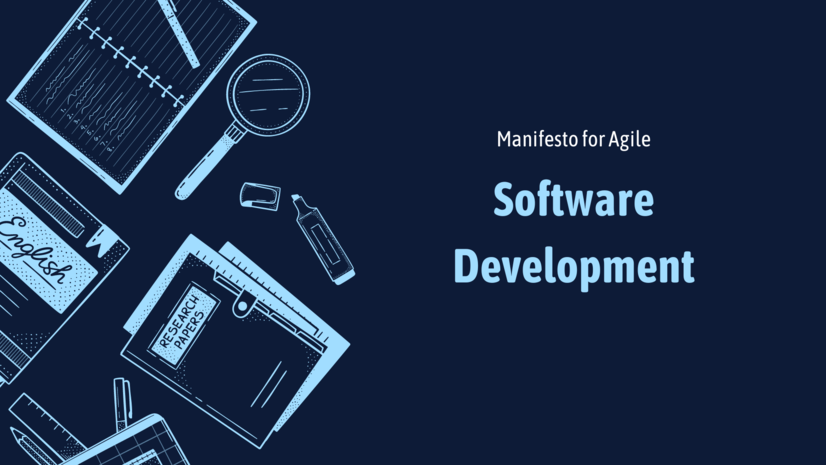Individuals and Interactions over Processes and Tools
In many organizations, there's a tendency to rely heavily on processes and tools to drive productivity and efficiency. While processes and tools certainly have their place, the Agile Manifesto reminds us that the most valuable assets in any organization are its people and the interactions between them.
- Fostering a Culture of Collaboration: Embracing the value of individuals and interactions means prioritizing teamwork, communication, and collaboration. Rather than rigidly adhering to predefined processes, organizations should create an environment where team members are encouraged to collaborate, share ideas, and leverage each other's strengths.
- Cross-Functional Teams: Break down silos and encourage collaboration by forming cross-functional teams composed of individuals with diverse skills and expertise.
- Open Communication Channels: Create channels for open communication, such as regular team meetings, stand-ups, and brainstorming sessions. Encourage team members to voice their ideas, concerns, and feedback freely.
- Empowering Individuals: Empower team members to take ownership of their work and make decisions autonomously. Provide opportunities for personal and professional growth through training, mentorship, and skill development programs.
- Valuing Human Relationships : At the heart of the Agile approach is a recognition of the importance of human relationships in driving success. Strong interpersonal connections foster trust, empathy, and a shared sense of purpose among team members.
- Building Trust: Cultivate a culture of trust and mutual respect within teams by fostering transparency, honesty, and accountability. Trust enables teams to collaborate more effectively and navigate challenges with confidence.
- Embracing Diversity: Embrace diversity and inclusivity within teams, recognizing that diverse perspectives lead to more innovative solutions and better outcomes. Create an environment where everyone feels valued and included, regardless of their background or identity.
- Celebrating Successes: Recognize and celebrate the achievements and contributions of individual team members. Acknowledging successes fosters a sense of camaraderie and motivates team members to continue striving for excellence.
- Embracing Agile Principles: By prioritizing individuals and interactions over processes and tools, organizations can embrace the core principles of Agile methodology:
- Adaptability: Agile teams are empowered to adapt to changing requirements and circumstances by leveraging the collective expertise and creativity of team members.
- Continuous Improvement: Encourage a culture of continuous improvement, where teams reflect on their processes and practices, identify areas for enhancement, and iteratively refine their approach over time.
In summary, prioritizing individuals and interactions over processes and tools is fundamental to embracing the Agile mindset. By fostering a culture of collaboration, trust, and inclusivity, organizations can unleash the full potential of their teams and drive greater innovation and success.
Working Software over Comprehensive Documentation
Traditionally, software development processes have placed a heavy emphasis on creating extensive documentation to outline requirements, design specifications, and implementation details. While documentation serves an important purpose, the Agile Manifesto advocates for prioritizing the delivery of working software over exhaustive documentation.
- Embracing Iterative Development: The Agile approach to software development emphasizes iterative cycles of development, where small, incremental improvements are made to the software with each iteration. Rather than waiting until all aspects of the software are fully documented before beginning development, Agile teams focus on delivering functional software early and often.
- Minimum Viable Product (MVP): Identify the core features and functionalities required to deliver value to users and prioritize their development. By focusing on building a minimal viable product, teams can quickly validate assumptions, gather feedback, and iterate based on user input.
- Continuous Delivery: Adopt continuous integration and continuous delivery practices to streamline the process of deploying software updates to production. By automating build, test, and deployment processes, teams can deliver new features and fixes to users more frequently and reliably.
- Balancing Documentation and Delivery: While Agile encourages minimizing documentation, it's important to strike a balance between documenting essential information and delivering working software. Documentation should be lightweight, focused, and tailored to the needs of the team and stakeholders.
- User Stories and Acceptance Criteria: Use user stories and acceptance criteria to capture requirements in a concise and actionable format. User stories describe the desired functionality from the perspective of the end user, while acceptance criteria outline the conditions that must be met for a user story to be considered complete.
- Just-In-Time Documentation: Adopt a just-in-time approach to documentation, where documentation is created as needed and evolves alongside the software. Rather than investing time in exhaustive upfront documentation, focus on documenting key decisions, design rationale, and changes as they occur.
- Prioritizing Working Software: Ultimately, the goal of software development is to deliver value to users through functional, usable software. By prioritizing the delivery of working software over comprehensive documentation, Agile teams can:
- Validate Assumptions: Validate assumptions and hypotheses through real-world usage of the software, allowing teams to course-correct and iterate based on user feedback.
- Reduce Time to Market: Accelerate time to market by delivering features incrementally, allowing users to start benefiting from new functionality sooner and providing opportunities for early revenue generation.
In summary, prioritizing working software over comprehensive documentation enables Agile teams to deliver value to users more efficiently and effectively. By embracing iterative development and balancing documentation with delivery, organizations can maximize the impact of their software development efforts.
Customer Collaboration over Contract Negotiation
Traditionally, software development projects have been guided by detailed contracts and agreements negotiated between the development team and the client or stakeholders. However, the Agile Manifesto emphasizes the importance of collaboration and partnership with customers throughout the development process, rather than relying solely on formal contracts.
- Engaging Customers as Partners: In the Agile approach, customers are viewed as partners in the development process, rather than distant stakeholders with whom contracts must be negotiated. By actively involving customers in the development process, teams can ensure that the software meets their needs and expectations more effectively.
- Early and Frequent Feedback: Engage customers early and frequently to gather feedback on the evolving software. By soliciting input throughout the development process, teams can validate assumptions, identify potential issues, and prioritize features based on customer priorities.
- Collaborative Planning: Collaborate with customers to prioritize features and define requirements based on their needs and goals. Rather than relying on a fixed set of requirements outlined in a contract, Agile teams work closely with customers to adapt to changing priorities and emerging opportunities.
- Embracing Transparency and Flexibility: Agile principles encourage transparency and flexibility in customer relationships, allowing for open communication, trust, and collaboration.
- Transparency: Foster transparency by providing customers with visibility into the development process, including progress, challenges, and decisions. Regular demonstrations, status updates, and access to project artifacts help build trust and alignment between teams and customers.
- Flexibility: Embrace flexibility by being responsive to customer feedback and changing requirements. Agile teams are empowered to adjust their plans and priorities based on customer input, allowing for greater adaptability and responsiveness to evolving needs.
- Building Strong Customer Relationships: By prioritizing collaboration over contract negotiation, organizations can build stronger relationships with their customers, leading to greater satisfaction and success.
- Partnership Mentality: Cultivate a partnership mentality with customers, where both parties work together towards shared goals and outcomes. By aligning interests and priorities, teams and customers can achieve greater success together.
- Customer Satisfaction: Ultimately, the goal of customer collaboration is to maximize customer satisfaction by delivering software that meets their needs and expectations. By involving customers throughout the development process, teams can ensure that the final product reflects their vision and requirements.
In summary, prioritizing customer collaboration over contract negotiation enables organizations to build stronger relationships with their customers and deliver software that better meets their needs. By embracing transparency, flexibility, and a partnership mentality, Agile teams can drive greater satisfaction and success for both parties.
Responding to Change over Following a Plan
In traditional project management approaches, detailed plans are often created at the outset of a project and adhered to rigidly throughout its execution. However, the Agile Manifesto recognizes that change is inevitable and advocates for embracing flexibility and responsiveness to change over rigid adherence to a predefined plan.
- Embracing Uncertainty and Adaptability: The Agile approach acknowledges that requirements, priorities, and circumstances can change rapidly, and organizations must be prepared to adapt accordingly. Rather than viewing change as a disruption or deviation from the plan, Agile teams embrace it as an opportunity for improvement and innovation.
- Iterative Planning: Adopt an iterative approach to planning, where plans are continually refined and adjusted based on new information and changing circumstances. Agile teams prioritize delivering value early and often, allowing for course corrections and adjustments as needed.
- Embracing Uncertainty: Embrace uncertainty and ambiguity as inherent aspects of complex projects. Rather than striving for certainty and predictability, Agile teams focus on building resilience and adaptability, enabling them to respond effectively to changing requirements and environments.
- Agile Principles for Change Management: Agile methodologies provide a set of principles and practices for managing change effectively throughout the development process.
- Continuous Feedback: Seek and incorporate feedback from stakeholders and end users regularly to validate assumptions and inform decision-making. By gathering feedback early and often, teams can identify and address issues before they escalate.
- Adaptive Planning: Embrace adaptive planning techniques, such as iterative development, incremental delivery, and frequent retrospectives, to adjust plans and priorities based on changing requirements and feedback.
- Embracing Change as an Opportunity: Rather than viewing change as a threat, Agile teams embrace it as an opportunity for learning, growth, and improvement.
- Innovation and Experimentation: Encourage a culture of innovation and experimentation, where teams are empowered to explore new ideas, technologies, and approaches. By embracing experimentation, teams can discover new solutions and opportunities for value creation.
- Continuous Improvement: Foster a culture of continuous improvement, where teams reflect on their processes, practices, and outcomes, and seek opportunities for enhancement. By embracing a mindset of continuous learning and adaptation, teams can thrive in dynamic and uncertain environments.
In summary, prioritizing responsiveness to change over following a plan enables organizations to embrace uncertainty, adaptability, and innovation. By adopting Agile principles and practices for change management, teams can navigate complexity more effectively and achieve greater success in their projects.
Conclusion: Embracing Agile Values for Success
The Agile Manifesto embodies a set of values and principles that have revolutionized the way organizations approach software development and project management. By prioritizing individuals and interactions over processes and tools, working software over comprehensive documentation, customer collaboration over contract negotiation, and responding to change over following a plan, Agile organizations can achieve greater agility, innovation, and success.
In this story, we've explored how to apply the four key values of the Agile Manifesto within your organization:
- Prioritize Collaboration: Foster a culture of collaboration and teamwork, where individuals are empowered to work together towards shared goals and outcomes.
- Deliver Value Early and Often: Focus on delivering working software early and frequently, prioritizing the features and functionalities that provide the most value to customers.
- Engage Customers as Partners: Collaborate closely with customers throughout the development process, soliciting their feedback, and adapting to their evolving needs and priorities.
- Embrace Flexibility and Adaptability: Embrace change as an opportunity for growth and improvement, adjusting plans and priorities based on new information and feedback.
By embracing these principles, organizations can unlock the full potential of their teams, deliver higher quality software, and ultimately, achieve greater success in their projects.
As you embark on your Agile journey, remember that Agile is not a destination but a mindset—a way of thinking and working that values flexibility, collaboration, and continuous improvement. By embracing the Agile Manifesto values and principles, you can transform your organization and thrive in today's fast-paced and dynamic business environment.
Are you ready to embrace Agile and unlock your organization's full potential ? Join us on the Agile journey and discover the power of collaboration, innovation, and adaptability.









